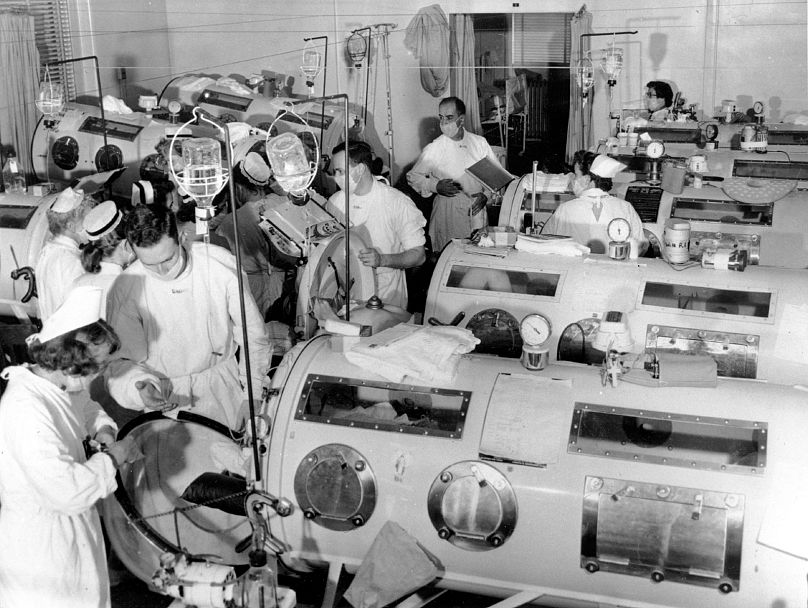Poliomyelitis, an untreatable but preventable disease, is only endemic in two countries globally but many believe it could be eradicated.
The world is getting closer to eradicating polio, with experts hoping to eliminate it this decade - but challenges remain to make sure all children are vaccinated.
Wild poliovirus cases have decreased by 99 per cent from hundreds of thousands of cases in 1988 to just nine reported cases in Afghanistan and Pakistan this year. This is already fewer cases than there were in 2022.
“We're really closing in on the virus in a very small area, and there's a huge effort going on to eliminate it,” Judith Diment, the charity Rotary International’s advocacy adviser for the UK, told Euronews Next.
Smallpox is the only virus that has been eradicated in humans worldwide, but experts are hopeful that polio could be next.
While there hasn’t been a case of wild poliovirus in Europe in more than two decades, experts have warned that as long as polio remains endemic in two countries, it could be imported everywhere.
“Failure to eradicate polio from these last remaining strongholds could result in a global resurgence of the disease,” according to the World Health Organization (WHO).
Wild poliovirus was imported from Pakistan to Malawi and Mozambique in 2021 and 2022, causing nine cases.
Meanwhile, vaccine-derived poliovirus, which is a strain related to the weakened live poliovirus contained in the oral vaccine, can also circulate in areas that are under-immunised. Hundreds of these cases are still reported, in countries such as the Democratic Republic of the Congo, Yemen, Somalia, and Nigeria.
There was one case that caused paralysis in an unvaccinated individual in New York in the US last year.
Vaccine-derived poliovirus was also detected in summer 2022 in London sewage as part of ongoing wastewater surveillance. This prompted the declaration of public health emergencies.
What is polio and why have cases gone down so much?
Poliomyelitis, also known as polio, is a highly infectious disease that mostly affects young children. It cannot be treated but is preventable when people are vaccinated.
It is most often spread by contact with the faeces of an infected person but could also be spread through contaminated water or food.
While most people will not develop symptoms of polio, around a quarter of people develop flu-like symptoms.
According to the WHO, one in 200 infections of polio leads to “irreversible paralysis,” with around 5 to 10 per cent of those who become paralysed dying from the illness. At its peak in 1952, there were 20,000 cases of paralytic poliomyelitis in the United States.
People who were paralysed were sometimes treated with the Iron Lung, a bulky machine that acted as a ventilator for people with a paralysed diaphragm who could not breathe on their own.
One of the first effective vaccines was developed by Jonas Salk who first tested it on himself and his family in 1953. His inactivated poliovirus vaccine was licensed in 1955, with World Polio Day marking the biologist’s birth.
The oral polio vaccine developed by Albert Sabin, which could be given with drops or on a sugar cube, made it easier for mass vaccination campaigns and was used in Hungary in 1959 as part of a mass campaign.
Challenges remain for eradication
Rotary International’s Diment, who has been working on polio eradication advocacy since 1996, says that there are still challenges present as organisations work to end polio.
“Because we're so close, everybody wants to get the job done. But having had the COVID pandemic, of course, which has altered the whole world and the way we operate, there are many challenges and many competing issues for funding,” she said.
A recent funding partnership between the European Union, European Investment Bank (EIB) and Bill & Melinda Gates Foundation has promised €500 million in new funding for the Global Polio Eradication Initiative (GPEI) that will help to vaccinate more children.
Diment says this is “hugely important” and that the effort needs “every last penny of it”.
But there are many challenges in remaining countries including inaccessible children, violence, and anti-vaccine sentiment. Low levels of vaccination and surveillance can create the risk of another outbreak.
A paper publishedin the New England Journal of Medicine in February said that part of the failure to eradicate polio so far has been due to the continued appearance of vaccine-derived cases.
They argue in favour of continued efforts to create universal immunity to the virus.
“It's a horrible disease which incapacitates people and puts them into wheelchairs. We've saved 20 million children, so I don't want any child to get polio. We have to finish the job and make sure that we vaccinate every last child,” Diment said.













